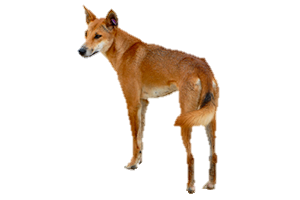Dingo
Boolomo, Maliki, Mirigung, Noggum, Warrigal

The Dingo is first and foremost a wild animal. Some have been kept as companions although this is highly controversial. The legality of owning a Dingo as a pet varies from state to state within Australia. Previously the Australian National Kennel Council had a written breed standard for the Dingo. However, it appears to have been removed from their classifications.
Dingo Standards
- none
- 19-24"
- 50-70 lbs
- medium-sized, primitive breed
- erect, triangular ears
- long tail, carried in a sickle shape
- coat length varies on climate
- shades of red
- shades of tan
History of the Dingo
The Dingo was first brought to Australia from southeast Asia several thousand years ago. The oldest known fossil dates from 1450 BC, but most believe that they were there long before that date. Before the arrival of Europeans they were a large part of the aborigine's life. They were kept as companions, used for hunting and warmth on cold nights.
European settlers meant the introduction of livestock and once the Dingoes recognized them as prey the settlers saw Dingoes as pests. They became trapped, shot and poisoned, regardless if they were wild or the aborigine's. This continues today in parts of the country. Outcry has begun due to concerns that the breed may face extinction if the killings do not cease. The threat of hybridization from other dogs is just as dangerous. Estimates point to as few as 15-20% of remaining wild dogs as pure Dingo.
Fraser Island, located on the southeastern coast of Queensland remains the last stronghold for the Dingo. Crossbreeding with imported dogs is rare due to its location. However, the Dingoes are not fully protected. Incidents between tourists and Dingoes occur although rangers insist it is caused by people not heeding posted warnings.
